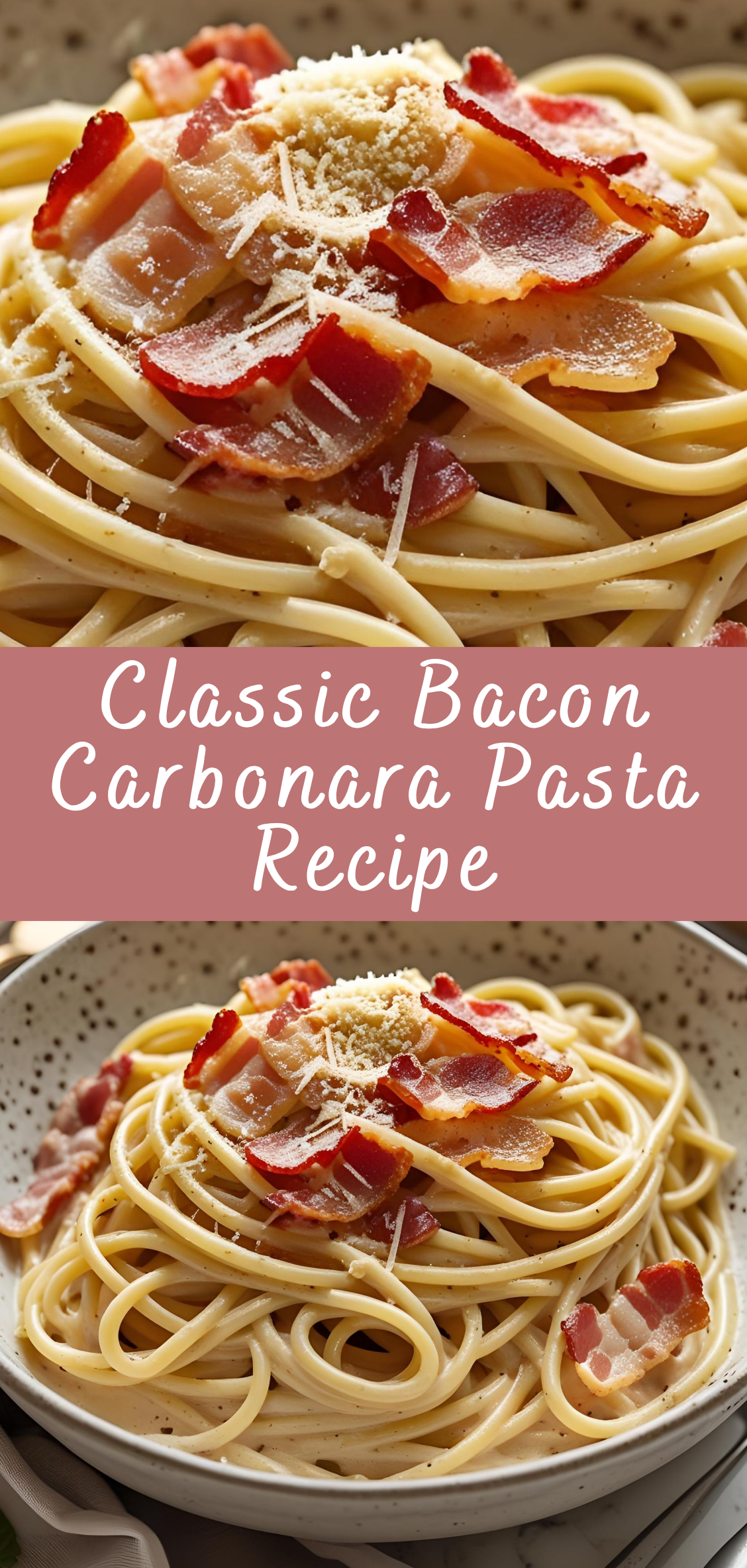Classic Bacon Carbonara Pasta Recipe
Classic Bacon Carbonara Pasta is a beloved Italian dish known for its rich, creamy texture and comforting flavors. Traditionally made with eggs, cheese, and black pepper, Carbonara has earned a special place in Italian cuisine and around the world for its simplicity and depth of flavor. While authentic Carbonara is typically made with guanciale, many home cooks use bacon as a delicious and more accessible alternative.

This dish is an excellent example of how a handful of simple ingredients can come together to create a dish that is greater than the sum of its parts. The silky sauce clings to the pasta, enriched by the savory, smoky bacon and a sharp, salty cheese such as Pecorino Romano or Parmesan. The result is a harmonious balance of creamy, smoky, and peppery notes that make Carbonara irresistible.
The History of Carbonara
Carbonara’s origins are a subject of some debate, but it is widely accepted that the dish is a relatively modern creation within Italian cuisine. Unlike other pasta dishes that have centuries-old roots, Carbonara’s emergence is traced back to the mid-20th century, with various theories linking it to World War II and the influence of American soldiers in Italy.
One popular theory suggests that Carbonara was invented in Rome shortly after the war, inspired by the availability of American rations such as powdered eggs and bacon. Italian cooks are believed to have adapted these ingredients into a sauce to be tossed with pasta, resulting in what became the classic Carbonara.
Regardless of its exact origins, Carbonara quickly became a staple of Roman cooking and has since spread worldwide, celebrated for its straightforward preparation and satisfying flavor profile.
The Evolution and Cultural Context of Classic Bacon Carbonara Pasta
Carbonara is more than just a pasta dish; it’s a cultural emblem of Roman cuisine and a testament to Italian ingenuity in transforming simple ingredients into something extraordinary. Its roots, while debated, reflect Italy’s adaptive culinary spirit, where regional ingredients and historical circumstances shape beloved recipes.
Traditional Carbonara is typically made with guanciale, a cured pork cheek that provides a rich, fatty, and slightly sweet flavor distinct from bacon. However, outside of Italy, especially in the United States and other countries where guanciale is less common, bacon has become the popular substitute. While this changes the flavor profile slightly—bacon being smokier and often saltier—the dish’s essence remains intact, delivering the creamy, savory experience Carbonara lovers crave.
The hallmark of Carbonara lies in its sauce—a silky emulsion of raw eggs, finely grated cheese, and pasta water. When combined with hot pasta, this mixture gently cooks, coating the strands with a luscious, velvety texture without curdling or scrambling the eggs. The fat rendered from the bacon also plays a crucial role, imparting flavor and richness.
Key Ingredients and Their Roles in Bacon Carbonara
-
Pasta: Traditionally, spaghetti is used, but other long pastas like linguine or fettuccine work well too. The pasta should be cooked al dente to provide the ideal texture to hold the sauce.
-
Bacon: Chosen for its smoky flavor and fat content, bacon adds a savory depth. It should be cooked until crisp but not burnt to preserve balance in flavor.
-
Eggs: The foundation of the creamy sauce, whole eggs or a combination of whole eggs and yolks create the sauce’s luscious texture.
-
Cheese: Pecorino Romano is the classic choice, contributing a sharp, salty tang. Parmesan can be used alone or combined with Pecorino for a milder, nutty flavor.
-
Black Pepper: Freshly cracked black pepper is essential for its pungency and heat, brightening the dish and balancing the richness.
-
Salt: Used sparingly to season pasta water and adjust final seasoning, considering the saltiness of bacon and cheese.
The Art of Perfecting Carbonara
Making perfect Carbonara requires attention to timing and technique. The key challenge is creating a smooth, creamy sauce without scrambling the eggs. This involves:
-
Cooking pasta to the right firmness.
-
Rendering the bacon fat carefully to maximize flavor without bitterness.
-
Combining eggs and cheese into a smooth mixture.
-
Tossing the hot pasta with the egg-cheese mixture off the heat, using reserved pasta water to loosen the sauce if needed.
-
Incorporating the crispy bacon and generous black pepper at just the right moment.
This balance of heat and mixing is what defines a great Carbonara, showcasing the harmony between texture and flavor.
Why Bacon Carbonara Remains Popular Today
Bacon Carbonara continues to be a beloved comfort food for several reasons:
-
Simplicity: Few ingredients are needed, making it accessible to cooks of all skill levels.
-
Speed: It can be prepared quickly, perfect for weeknight meals.
-
Flavor: The combination of smoky bacon, sharp cheese, and creamy sauce is deeply satisfying.
-
Versatility: Easily adaptable by adjusting cheese types, pasta shapes, or adding vegetables like peas or mushrooms.
Its enduring popularity is a testament to its perfect marriage of flavor, texture, and ease.
Classic Bacon Carbonara Pasta Recipe
Classic Bacon Carbonara Pasta is a beloved Italian dish known for its rich, creamy texture and comforting flavors. Traditionally made with eggs, cheese, and black pepper, Carbonara has earned a special place in Italian cuisine and around the world for its simplicity and depth of flavor. While authentic Carbonara is typically made with guanciale, many home cooks use bacon as a delicious and more accessible alternative.
Ingredients
- 12 oz spaghetti or your favorite pasta
- 6 slices bacon, diced
- 3 large eggs
- 1 cup grated Pecorino Romano or Parmesan cheese
- 3 cloves garlic, minced
- Salt and freshly ground black pepper, to taste
- Fresh parsley, chopped (optional, for garnish)
Instructions
- Cook the pasta:
Bring a large pot of salted water to a boil. Cook pasta according to package instructions until al dente. Reserve about 1 cup of pasta cooking water and then drain the pasta. - Cook the bacon:
In a large skillet over medium heat, cook diced bacon until crispy, about 6-8 minutes. Remove bacon with a slotted spoon and set aside on paper towels to drain. Leave the bacon fat in the skillet. - Prepare the sauce:
In a bowl, whisk together eggs, grated cheese, and a generous amount of black pepper. - Cook the garlic:
In the skillet with bacon fat, add minced garlic and sauté for about 1 minute until fragrant (don’t burn it). - Combine pasta and sauce:
Add the hot drained pasta to the skillet with garlic and toss to coat in the bacon fat. Remove the skillet from heat. Quickly pour in the egg and cheese mixture, tossing vigorously to create a creamy sauce. Add reserved pasta water a little at a time as needed to loosen the sauce and make it silky. - Add bacon and serve:
Stir in the crispy bacon. Taste and adjust seasoning with salt and pepper. Garnish with fresh parsley if desired and serve immediately.
Notes
- The key to creamy carbonara is to add the egg mixture off the heat and toss quickly so the eggs don’t scramble.
- Use freshly grated cheese for the best flavor and texture.
- Pecorino Romano gives a sharper, tangier taste; Parmesan is milder and sweeter.
- For an extra touch, sprinkle some more cheese on top before serving.



